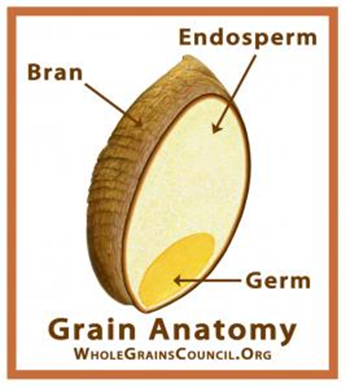Make the most of your grains
Feel full and boost energy by incorporating whole grains in your day.
How do you tell if an item is whole grain? Michigan State University Extension encourages you to become familiar with your food label. The ingredients list is the only accurate way to know if a product meets its label claim. You want to look for the first ingredient to be whole wheat flour, 100 percent whole grain rolled oats, etc. Ingredients are listed in order according to the quantity contained in the product. Packaging phrases such as “high fiber” and “contain whole grain” can be used when a product is a mixture of flours.
flour, 100 percent whole grain rolled oats, etc. Ingredients are listed in order according to the quantity contained in the product. Packaging phrases such as “high fiber” and “contain whole grain” can be used when a product is a mixture of flours.
Whole Grains: Whole grain flour, oats, barley, brown rice, whole corn meal.
Refined/Enriched Grains: White flour, enriched flour, white rice.
Making simple switches toward the recommended “half your grains whole” will have a big impact on health and satisfaction from food. Start with foods you already eat. Great ways to do that include:
- Start your day off smart—eating a whole grain item like oatmeal, cereal, a whole wheat waffle or pancake combined with a fruit and dairy will jump start your metabolism, increase your energy and give you the satisfying, full feeling.
- Breads, tortillas, chips and crackers—not all whole wheat products are dark in color. There are white breads made with whole wheat flour. Not only can color be deceptive but so can price or brand. Whole grain products can be found in store brand products as well as national brand names.
- Pasta—Keep in mind cooking times may vary when making this switch and it may need to be introduced several times to get used to the change.
- Baked goods—In recipes (muffins, cookies, cakes and the like) calling for all-purpose flour, include whole wheat flour by adjusting the called for amount equally between the two flour types. Whole wheat flour increases the density and should not be completely switched in a recipe.
Being mindful of your need for whole grains and sustaining small changes will benefit your energy level, overall health and all the while make you feel fuller.
MyPlate and the Dietary Guidelines of 2010 recommend adults and teens (14-18), depending on age and gender, eat between five and eight ounces of grains a day, while children (ages two through 13) need three to six ounces a day. Of those ounces, making half of them whole grain will provide maximum nutrients and energy. So what is whole grain and how can you incorporate it?
Whole grain means that 100 percent of the original kernel is intact and not removed in processing. The bran and endosperm of the kernel are high in fiber, which is beneficial for digestive health and the fullness sensation. Refined grains have a finer texture and longer shelf lives.



 Print
Print Email
Email

